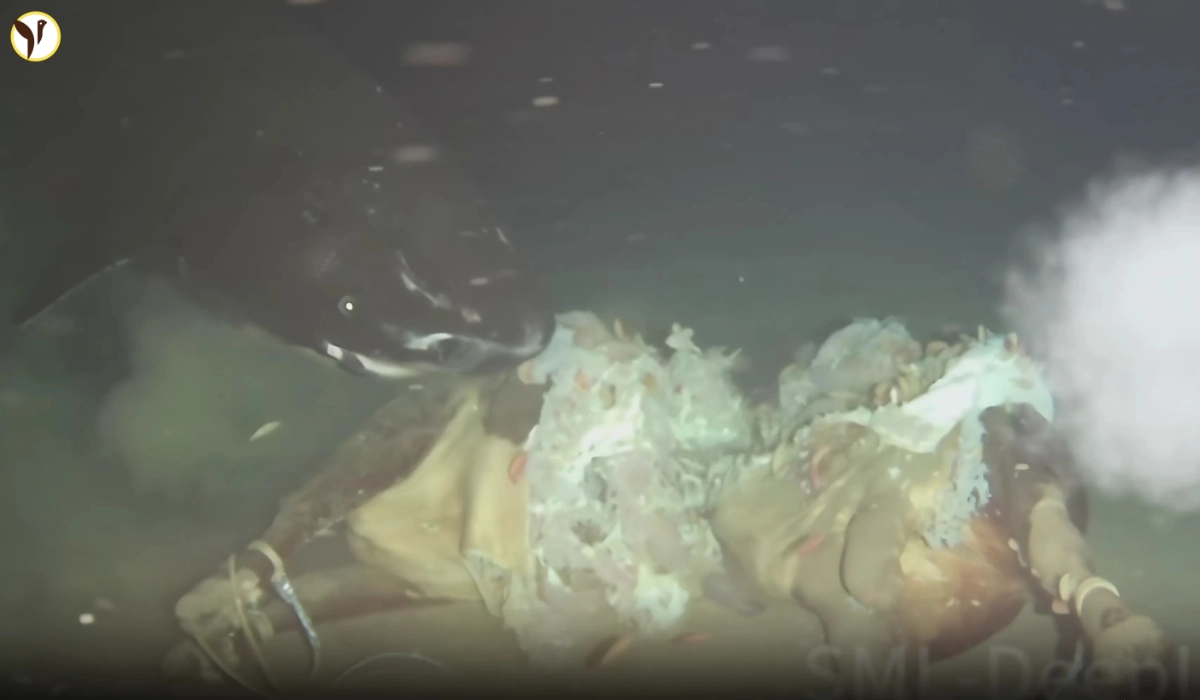Something unexpected drifted into the far northern South China Sea. Down to some 1,629 meters depths, cameras caught sight of something no one imagined could be found there: a mob of Pacific sleeper sharks, an animal found only in cold northern oceans.
Imagine this: a cow carcass dumped onto the seafloor. Then—bam—a couple dozen-foot shark cruises into view. It wasn’t alone. Out of that first view, there were eight sharks, each ranging from 1.9 to 5.1 meters, long, black, slow-moving, and enigmatic. Video showed a group of sharks tearing flesh but in a tempered fashion—in a polite way, it seemed. The largest shark moved first, followed by a queue of smaller sharks waiting to eat. They were not frenzied voracious creatures; simply quietly and purposefully consuming flesh.
This revelation shattered the long-held idea that these massive animals only resided in northern waters. Here they were situated in tropical waters—the waters depths may maintain cold enough temperature, yet it still provided a surprise. I likened the experience to unexpectedly finding elephants grazing in your backyard—we all know elephants don’t visit backyards!
A female-only shark gathering and a feeding line
What had scientists scratching their heads was this: all eight sharks were female. No male sharks. This is an interesting observation. In shark language, this indicates that part of the South China Sea could be classified as nursery region or, at a minimum, a meeting area for about to be moms.
To add to this, there’s the exhibit's strange feeding behavior-queueing. The big ones go first, the little ones circle back, and they wait in line-it’s very polite, almost civilized behavior (not what you normally expect from sharks). It suggests some complex social cues and maybe some type of hierarchy, which is surprising in the depths of the blue.
There’s a lovely tension in the watching-you see their restraint and perhaps their respect. The sharks are certainly not fighting for calories, they are enjoying a shared feast together. You felt like you were spectating a secret society in the deep dark sea.
Ever seen a shark queue for dinner? The Pacific sleeper shark has surprising table manners 🦈
— Science Partner Journals (@SPJournals) June 27, 2025
Learn more about their fine-sea dining habits here: https://t.co/zpUZPL0cEK#sharks #oceans #marinebiology pic.twitter.com/0P49tdRMcO
Eye protection, parasites, and unseen mysteries
You could add another layer to the narrative. When the sharks chew meat, they retract their eyes into their sockets. This behavior, as they have no eyelids, is probably a protective mechanism for their eyes. It is a unique deep-sea feature, so far.
Then, what was scarcely mentioned elsewhere, were the little lice or copepods or whatever they may be that are on their skin, and eyes. You can see them in the new footage. These passive partners (that don't seem to get any attention), tell a remarkable story themselves: even in the deep, sharks are the host to a sub-ecosystem.
And around the carcass, it’s not just sharks—it’s a full deep-sea buffet. Amphipods, snailfish, giant isopods known as Bathynomus. All drawn to the same meal. That shows the area is a rich biodiversity hotspot, surprising for what many think of as a barren zone.
Why this discovery matters now
This isn’t just a cool shark video. It shakes how we think about the deep ocean:
-
Range expansion: A predator once thought to hate warm waters is now hanging near the tropics. What’s changed? Currents? Climate? Food availability?
-
Behavior insight: Female-only groups and queueing suggest complex ways of living we knew nothing about.
-
Ecosystem health: Seeing a full food chain in action suggests more life here than we guessed—and that matters if we think of conservation or climate change.
It sparks new questions. Are these sharks here year-round? Do they breed here? Is the food so good deep down that it’s pulling them away from cold seas?
What’s next under the waves
Yeah, we know more, but there’s so much we don’t know:
-
Tagging missions: We need to follow them—where they go, how often they come here, and if they return.
-
Genetic checks: Are they locals or tourists? DNA could show if they’re born here or just passing by.
-
Parasite story: What’s living on them and why? That shows more about deep-sea life.
-
Climate link: Is warming water pushing them south? Maybe warm upper layers aren’t stopping them anymore.
Bullets at a glance
-
Eight Pacific sleeper sharks filmed at 1,629 m depth near Hainan Island
-
All were females—potential nursery area
-
Showed calm, structured queue feeding
-
Retracted eyes during feeding—protective behavior
-
Parasites visible—new detail in shark biology
-
Other deep-sea creatures lined up too
-
Suggests a rich ecosystem, not barren bottom
Final thoughts: deep-sea wonder
Watching this footage is like breathing in cold, dark mystery. It feels new, raw, real. You get emotionally pulled into that deep moment—the slow glide, the shared meal, the quiet of the sea.
And it’s not about me. It’s about them. These sharks, these deep creatures, just living their lives in ways we’re only starting to decode. It’s a glimpse into a world as real as ours, hidden beneath miles of water.









